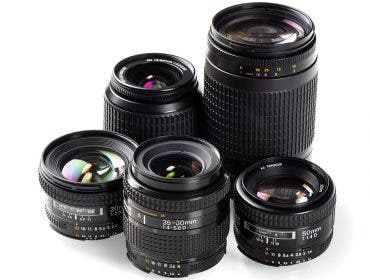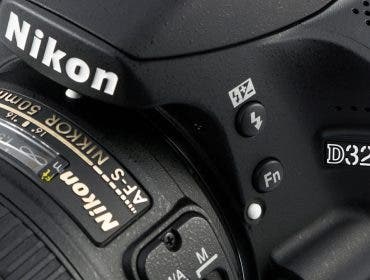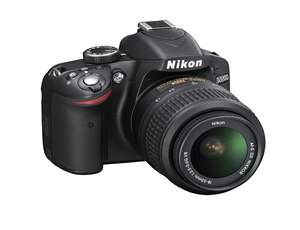It’s the highest-resolution entry-level DSLR in current production; can it deliver best-in-class image quality?

The signature feature of the new Nikon D3200 entry-level DSLR, available at Adorama and the one that has created the most buzz among enthusiasts, is its 24.2 MP, DX-format, APS-C size CMOS sensor, making it the highest resolution image capture device to be found in any entry-level DSLR and a whopping 10.1 MP higher than the sensor in its pleasantly competent, well-esteemed predecessor, the Nikon D3100. However, while the D3200 (available from Adorama in Black or Red) looks quite similar to the D3100 (which is still available at a reduced “Instant $100 Rebate” Adorama price of $546.95 with 18-55mm zoom), its spec sheet proves that it’s a lot more than just a warmed over hi-res version. In this exclusive Adorama Learning Center report, I put the Nikon D3200 through its paces.
Features
For starters, the Nikon D3200 incorporates Nikon’s state-of-the-art EXPEED III image processor, the same one used in the pro Nikon D4, that delivers, among other things, quicker AF, shorter shutter lag times, an expanded dynamic range, and a claimed maximum burst rate of 4 fps (up from 3 fps on the D3100). The LCD is still a fixed (non-articulated) 3-inch unit with Live View and 4 AF area modes (Face-Priority, wide-area, normal area, subject-tracking and full-time servo AF (AF-F) that locks onto moving subjects), but its resolution has been substantially increased to a pro-class 921k dots (up from 320k) for enhanced sharpness and easier assessment of fine details for precise focus confirmation.
The 11-point AF system (with single-point, Dynamic-area, 3D-tracking (11 points), and Auto-area options) and ISO settings (from ISO 100-6400 plus 12800 in Hi and Auto ISO) are essentially unchanged. HD video and remote control operation, however, have been notably upgraded with an external stereo microphone jack (for the optional ME-1 Stereo Microphone) and a jack for the optional WU-1a, a wireless mobile adapter that lets you send images automatically to your smart phone or even use your phone as a remote control to take pictures or record video!

Coffee beans still life: Nikon’s 18-55mm VR kit lens delivers excellent imaging performance wide open at 55mm (82.5mm equivalent) with nice bokeh in foreground. Camera’s color saturation and color accuracy at low ISOs are outstanding. Exposure: f/5.6 at ISO 250.
While the Nikon D3200 lacks built-in auto-bracketing and the full range of creative filter effects found in some of its leading competitors, it is nevertheless a broad-spectrum, full-featured, entry-level DSLR that will appeal to serious enthusiasts looking for a compact, lightweight, economical interchangeable-lens camera that delivers high imaging performance and easy eye-level viewing.
Nikon has thoughtfully retained a number of features designed to provide a fulfilling shooting experience for beginners. Chief among these is the Guide setting on the main mode dial, which calls up the Guide Mode screen on the LCD, and lets you select from among Shoot, View/delete, or Set-up menus and open them pressing the OK button. In the Shoot menu, the camera will walk you through Easy Operation or Advanced menus that describe each mode in clear, non-technical language and let you set the camera easily based on your mission or subject type.

In the View/delete menu you can access a range of view/delete options such as “single frame,” and the Set-up menu lets you set basic picture taking parameters like image quality and size, or a range of movie options including file size, framing rate, and flicker reduction. The green Auto mode and Scene Auto Selector also make it easy for novices to get generally excellent results easily by using the camera like a sophisticated point-and-shoot with basic settings predetermined.
Weighing in at exactly one pound (body only) and 9.5 ounces more with the standard AF-S Nikkor 18-55mm f/3.5-5.6 VR test lens (27mm wide angle to 83mm medium telephoto 35mm equivalent), the Nikon D3200 is a compact, handy, well-balanced machine that feels great to hold in your hands. Its built-in right-hand grip is ergonomically contoured, placing your index finger perfectly over the angled shutter release, which has a commendably light, smooth, predictable action.
The lens looks chunky compared to the camera body but it does provide Nikon’s VR (Vibration Reduction) image stabilization system that, in my estimation, delivers about a 3-plus-stop advantage when shooting handheld at slow shutter speeds, at telephoto settings, or in low light. I also liked the big 1-1/2-inch-wide textured zoom ring that turns very smoothly with a well-damped action, but were less thrilled with the thin front mounted manual focus ring. Its action is under-damped and it takes only about 1/8 or a turn to move it from infinity to closest distance (0.9 feet), making it difficult to focus manually with precision. On the plus side, the lens’s maximum magnification ratio of 1:3.2 lets you shoot impressive close-ups of flowers, faces, and collectibles. Like other Nikon DSLRs in its class, the D3200 does not have an in-body AF motor, and will only autofocus with AF-S and other Nikkor lenses that have their own built-in AF motors.

Horsin’ around: Handheld grab shot of kids having fun at nighttime 4th of July fireworks display captures the magic moment, but image shows considerable noise and some loss of color saturation at the D3200’s highest normal-range ISO setting. VR image stabilization built into 18-55mm Nikkor VR lens did a good job at minimizing the effects of camera shake at a slow shutter speed. Exposure: 30mm (45mm equivalent), f/4.5 at 1/25 sec, IS0 6400.
Control layout and modes
In general, the camera’s controls are very well laid out and logical. The Menu button to the left of the LCD lets you scroll among 5 comprehensive menu choices—Playback Menu, Shooting Menu, Setup Menu, Retouch Menu (which includes a range of post-production effects including D-lighting exposure adjustment, Red-Eye correction, color balance, image overlay, and a limited array of filter effects), and Recent Settings, which is very useful when changing camera settings for only one or two images. Pressing the info (I) button provides even faster access to frequently used camera settings including image quality, white balance, ISO, metering pattern, and exposure and flash compensation.
In addition there are clearly labeled dedicated buttons for exposure compensation, Live View, drive mode/self-timer, and zooming the LCD display to assess details or composition. All setting selections except those for aperture and shutter speed are controlled using the four-way toggle switch and enabled by pressing the OK button. Actual exposure settings (aperture and shutter speed) are selected by turning the milled thumbwheel conveniently placed on the back of the camera below and to the right of the main mode dial. The only setting I didn’t like was the single-point AF (spot-metering) selector that’s controlled by the 4-way toggle switch. When you turn on the camera and activate it by touching the shutter release, the red viewfinder LED corresponding to the AF point in use flashes for a fraction of a second to give you a heads-up, but it’s all too easy to move the AF point accidentally by touching the toggle switch at the wrong time, and then to miss the brief warning before you take shot with the AF in the wrong place. The cure: Turn on the AF confirmation beep by setting Noise reduction to Off, and make sure the right LED is flashing when you hear the beep and follow through to take the shot.

“Why are you taking my picture?” Cute close-up of a pouting toddler shows excellent definition of 18-55mm Nikkor VC lens wide open near its longest setting, and excellent definition, ultra-low noise, and creamy skin tones at a low IS0. Exposure: 52mm (78mm equivalent), f/5.6, ISO 450.
Performance
Fortunately the areas where the Nikon D3200 really shines are the most critical ones for discriminating users—speed, responsiveness, and outstanding image quality. In all but the dimmest light, the camera’s phase-detection AF system focuses very quickly and decisively. Its shutter release lag time is very short—on the order of 0.6 sec from pressing the release to capture. In very low light during an outdoor event at night, this process took about 1.5 sec—still a very good performance equal to many middle-tier DSLRs. We were also impressed by the camera’s ability to focus on a wide range of subjects, even those with relatively low contrast.
The Nikon D3200, in stock at Adorama, also provides continuous AF when shooting 1080p HD video at 30 or 24fps, or still images in Live View. This uses the contrast AF system, which is quite accurate but noticeably slower, and at times you can see (and hear) the camera focusing in your videos. Using the optional external stereo mike will eliminate the focusing noise, but the only real solution to the occasional visible “focus delay” when shooting movies is to switch to manual focus for certain subjects.
,

Motorcycle mechanic: Excellent overall image quality and superb color at a relatively high IS0. Note excellent skin tones in mixed light, a sign of above average AWB performance. Exposure: f.5.6 at 50mm (75mm equivalent), ISO 2200.
Image Quality
Lab test scores courtesy DxOMark; Used by Permission
Overall RAW image quality: Excellent (81)
Color Depth: Excellent (24.1 bits)
Dynamic Range: Excellent (13.2 stops)
Low Light ISO: Excellent (ISO 1200)
DxoMark lab test results show the Nikon D3200 delivers the best overall image quality of any APS-format sensor Nikon camera and is in a statistical dead heat with the Pentax K5 for best APS-sensor camera overall. Although ISO was consistently ½ stop less than the indicated speed, overall the Nikon D3200’s overall image quality scores were best in class.
Based on my extensive field test, the Nikon D3200 is capable of capturing still images of exceptional quality in full-resolution RAW and JPEG files, as well as breathtaking Full HD movies at ISO settings from ISO 100 to 800. Images shot at ISO 1600 and 3200 exhibited excellent definition with low to moderate noise, and at ISO 6400 and 12800 the camera delivered images that were still useable at moderate magnification, but on the noisy side for critical applications.
The verdict: The Nikon D3200 does indeed deliver the practical benefits of its ultra-hi-res sensor at low- to medium-high ISO settings, but at the highest settings of ISO 6400 and above, the increased pixel density does compromise image quality and there are a few competitive lower-res cameras (such as the 18 MP Canon EOS T3i) that do slightly better in delivering low noise at ISO 6400 and above. It’s a moot point unless you do extensive shooting at very high ISOs or in very dim light, but worth noting.
Like most other high-performance entry-level DSLRs, the D3200 has a penta-mirror viewfinder that’s not quite as bright (or expensive) as a true solid glass pentaprism finder. However, it does show a better-than-average 95% of the captured image and its magnification of 0.8X is about par for the course, exhibiting only a moderate “tunnel effect.” I found it more than satisfactory for 98% of my picture taking and the only times I wished for a bigger, brighter viewfinder was when I was shooting night events or in extremely dim light.

Meet Bob: Amusing character close-up is enhanced by mild perspective distortion (due to low shooting angle) at semi-wide 28mm focal length. Noise is evident when the image is viewed at high magnification (see 100% detail, below), but definition and color accuracy are surprisingly good at this high ISO. Exposure: 28mm (42mm equivalent), f/13, ISO 6400.

The AF-S DX Nikkor 18-55mm VR lens is definitely one of the best performing kit lenses I have ever used, delivering excellent contrast and sharpness across the image field even in the near=-macro range, and effective image stabilization throughout our test. Its sole deficit: slightly greater than average barrel distortion at the wide-angle end.

Flower power: Floral macro shot demonstrates the extended close-up capability (to 1:3) of the 18-55mm Nikkor VR lens. Stamen and pistil show superb definition and detail (see 100% detail, below), with beautiful bokeh in the soft background. Color accuracy is outstanding at lowest ISO. Exposure: 55mm (82.5mm equivalent), f/9, ISO 100.

Conclusion and recommendation
To answer the famous “customer review” question posted on retailer’s websites, yes, I would definitely recommend this handsome, user-friendly, high-performance DSLR to a friend whether he/she is a DSLR newbie or an experienced shooter on a budget that demands pro-level image quality. For a DSLR with an Adorama price of only $696.95 with the aforementioned 18-55mm lens, it is an outstanding value. That’s why I confidently predict that the Nikon D3200 is destined to be a best-seller.






